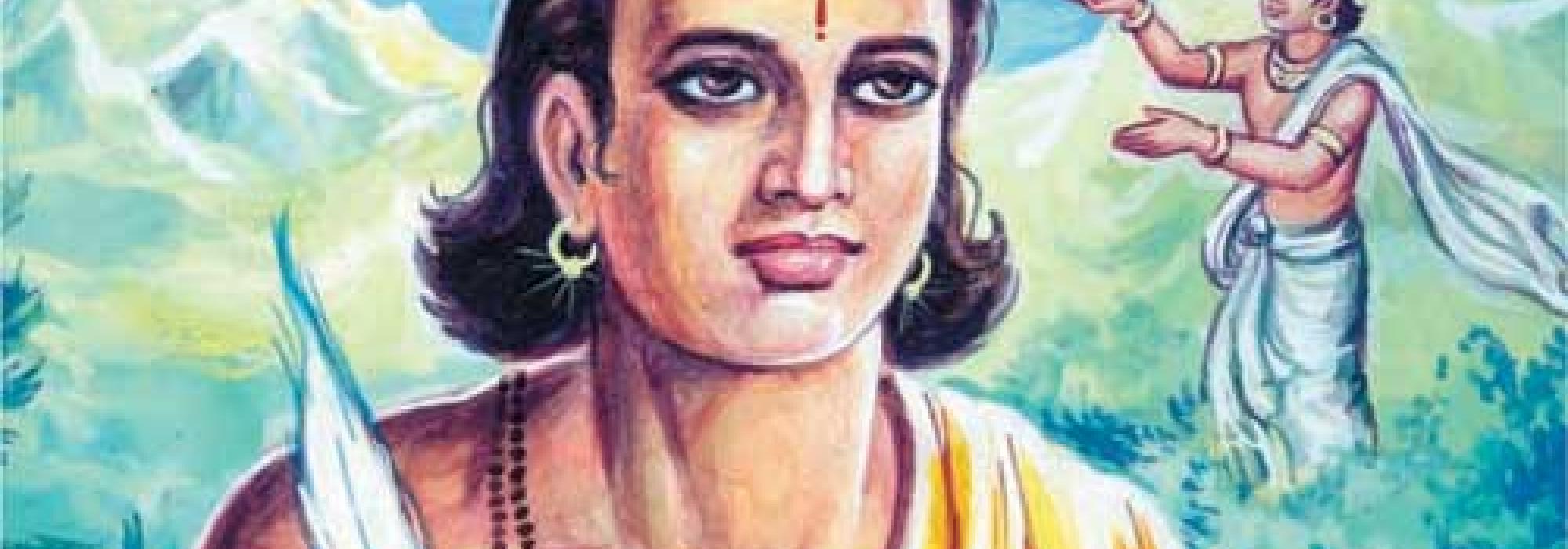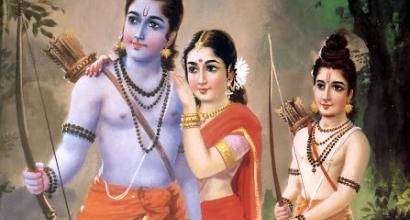It is difficult to tell when and where Kālidāsa lived, just as in the case of Bhāsa. Quite an amount of research has taken place on the subject and there have been numerous debates about the poet’s details. In fact, no other Sanskrit poet appears to have been discussed to this extent; however, we must admit that the search has not yielded the required results yet. Just as with Bhāsa, there are two diverging opinions about Kālidāsa’s life. Some Indian scholars have concluded that he lived in about 150 BCE; quite a few western scholars have arrived at the conclusion that he lived in about 400 CE. There are other views as well. Many such views are without basis and we will not discuss them. Instead, we will try to gain an overview of the manner in which scholars have arrived at the two diverging conclusions.
There are many stories in circulation about Kālidāsa’s life; one tale says that he was a shepherd and with the blessings of Devī Kālī, he blossomed into a great poet; another legend says that he was patronised by King Bhoja who ruled from Dhārānagara – Kālidāsa is supposed to have solved many poetic samasyās while at his court; yet another story says that Kālidāsa had travelled to the island of Ceylon during the times of Kumāradāsa and was defeated by a prostitute there. These are merely tales that have largely been in the oral circulation. From such stories, we can only gain an estimate of the enthusiasm and simplicity of people who popularized them; their innocent and non-analytical mind also gets revealed; but such tales hardly tell us any factual details about the great poet. Kālidāsa’s works reveal that he possessed an intimate knowledge of the Vedas, various śāstras, and purāṇas. Can we even believe that he became a great poet by chanting a bījākṣara? It appears like this is a story that grew around the name Kālidāsa and it must have developed limbs and wings in the course of time. King Bhoja lived in the eleventh century CE. It is easy to see from the points that follow that he could not have belonged to such late periods. Similar is the tale connected with Kumāradāsa; while it is true that Kumāradāsa was historical figure, we have enough evidence to prove that Kālidāsa lived before Kumāradāsa; the latter lived in about the sixth century CE. Kālidāsa’s affinity for the śṛṅgāra-rasa has probably resulted in tales which associate him with prostitutes.
There is yet another story connected with Kālidāsa; though it sounds quite fantastical like the rest, there is some semblance of truth in it; according to this tale, Kālidāsa was one of the nine gems in the court of King Vikramāditya. The names of the nine gems are listed in the verse below –
Dhanvantari-kṣapaṇakāmarasiṃha-śaṅku-
bhetālabhaṭṭa-ghaṭakarpara-kālidāsāḥ|
khyāto varāhamihiro nṛpatessabhāyāṃ
ratnāni vai vararucirnava vikramasya||
It is hard to say the period in which many of the scholars listed in the above verse lived. Among those whose periods we can tell with certainty, we get to know that they were not contemporaries of each other. Even if we were to establish that a few of them were contemporaries, we must note that Kālidāsa could not have lived after 587 CE. Therefore, we cannot be sure that the scholar-poets listed in the above verse were all contemporaries of Kālidāsa. Nevertheless, we might agree to some extent that it is quite possible that Kālidāsa lived in the times of King Vikramāditya.
Even if we go ahead accepting this fact, it is difficult to tell the exact period in which the great poet lived. India has seen many kings bearing the name Vikramāditya. The king who defeated the Śakas in 57 BCE and established his own reckoning of the years is known by the name Vikramāditya; it is traditionally believed that it was this Vikramāditya who patronised the nine gems. Scholars of the west do not seem to be convinced about pushing the date of Kālidāsa this far back in time. King Yaśodharma who lived in the sixth century CE also bore the title Vikramāditya. He is famous for having defeated the Huns. However, we have evidence to show that Kālidāsa lived before the sixth century and it is unlikely that Yaśodharma is the king referred to in the verse. Vikramāditya, who lived between the times of the two belonged to the Gupta dynasty; he was known by the name Candragupta II (357-413); his grandson Skandagupta (455-480) also bore the title Vikramāditya. Candragupta-Vikramāditya ruled from his capital city of Ujjayinī until about 413 CE. It is quite possible that he was Kālidāsa’s patron.[1] There are more data points which help us ascertain this fact – We find a clear imitation of Kālidāsa’s writing in the inscription made by Vatsa-bhaṭṭa in 473 CE. It is also possible that Kālidāsa has named his play Vikramorvaśīyam[2] to honour his patron, King Vikramāditya and has suggested the birth of the latter’s son Kumāra-gupta by naming his epic poem Kumārasambhava; it could have been to indicate the birth of Candragupta-Vikramāditya’s grandson Skanda-gupta as well; in his Mālavikāgnimitra, Kālidāsa mentions the performance of the aśvamedha, perhaps to suggest the yāga performed by Samudra-gupta. The works of Kālidāsa reflect a tranquil society living in peace and comfort. During the rule of the Guptas, our country was not under any kind of external threat; there was harmony within the country and resources were used in the best manner. People lived without anxiety. The country saw prosperity in all aspects. During the rule of Candragupta II, the country reached its peak in material as well as spiritual life. It naturally gave birth to the best of poets – Kālidāsa; his works are crowning glory to the literary world.
To be continued ...
The current series of articles is an enlarged adaption of Prof. A. R. Krishnasastri's Kannada treatise Saṃskṛta-nāṭaka. They are presented along with additional information and footnotes by Arjun Bharadwaj.
[1] It is said that Candragupta-Vikramāditya had sent Kālidāsa as an ambassador to the court of King Bhagīratha who ruled the kingdom of Kuntala (Kadamba). See Balasubrahmanya Iyer’s Bojana Śṛṅgāra-prakāśikā, A Study in Kalidasa in Relation to Political Science (P.O.C., Madras), p.6, Hemacandrana aucitya-vicāra-carcā (pages 30-40), George More sa – The Kadamba Kula; Jayaswal – J.B.O.R.S., March 1932
[2] The title of the play Vikramorvaśīyam also suggests the winning over of Urvaśī through valour (vikrama). However, it is more natural to interpret it as the story of Vikrama and Urvaśī, just as the title Mālavikāgnimitram is the story of Mālavikā and Agnimitra. In the Vikramorvaśīyam, the hero is Purūravas. The Vedas and the purāṇas do not name him Vikrama.
On similar lines, it has been said by scholars that Kālidāsa, in fact, describes the conquests of Samudra-gupta and other Gupta emperors through the portrayal of Dilīpa and other kings belonging to the Raghuvaṃśa – S.C.De, Kalidasa and Vikramaditya, Ch. III; J.R.A.S, 1909, 731











































